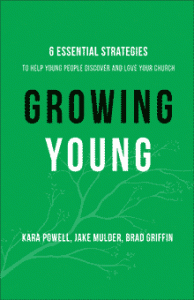What types of churches attract young people? Kara Powell, Jake Mulder, and Brad Griffin, the authors of Growing Young, dispel a number of common myths. Their research indicates that size, location, denominational tradition, worship style, and several other variables don’t matter as much as imagined and that congregations of all types have the potential to “grow young.”
Whether you’re a senior pastor, church staff member, ministry volunteer, parent, teenager, or young adult, if you are like us, you may be hindered by your preconceived image of what it takes to grow young. Odds are good that your picture of a thriving congregation has had branch after branch grafted on to it over time. Most of these branches stem from the experience of one person — either you or another (likely well-known) leader.
Even your images of successful ministry that are rooted in broader research are often several years — or decades — old. At this point, it’s hard to tell which branches have the potential to bear fruit and which are dead weight that drain the life from your congregation. Your ministry efforts are left wilting under the heavy burden of too many unrealistic expectations.
Granted, several of the congregations and leaders bubbling to the top of our research have a certain hip factor. But those were in the minority. For young people today, relational warmth is the new cool.
We need to prune distractions so the only branches remaining are those that help our churches grow young. Thanks to our research team’s surveys, interviews, and site visits with churches across the US, we can cross off these ten qualities from our list of what churches need to grow young.
- A precise size. Don’t buy into the Goldilocks fantasy that some churches are too big, others are too small, and some are “just right.” We saw no statistical relationship between church size and effectiveness. Size doesn’t matter.
- A trendy location or region. Did our data unearth churches flourishing near bustling urban centers and dynamic college campuses? Sure. But we also uncovered equally robust ministry in rural one-stoplight towns and middle-class suburbia. Your location does not have to be a limitation.
- An exact age. We applaud how God is working through new church plants. We love what we learned from churches that are less than five years old. But we learned just as much, and recorded just as much life change, in churches over a century old. When it comes to churches that grow young, there is no age discrimination.
- A popular denomination … or lack of denomination. When we started our study, we wondered if the churches that rose to the top would skew toward particular denominational, or nondenominational, leanings. While it’s true that some denominations are shrinking or aging faster than average, our fear was unfounded. No need to apologize for your tradition or the fact that you are part of a denomination at all. God is working powerfully through churches of all stripes (and plaids too).
- An off-the-charts cool quotient. Granted, several of the congregations and leaders bubbling to the top of our research have a certain hip factor. But those were in the minority. For young people today, relational warmth is the new cool.
- A big modern building. Some of the congregations that are most effective with young people have new, state-of-the-art facilities. But not all. The majority of the effective churches we studied gather in decent, but not spectacular, spaces. Some don’t own their facilities and are creatively meeting in local schools, community centers, and living rooms. For teenagers and young adults, feeling at home transcends any building.
- A big budget. Churches that grow young intentionally invest in young people, and most often that translates into a financial investment. But not always. Less resourced congregations creatively support young people in other ways, proving that a small budget does not have to mean small impact.
- A “contemporary” worship service. Our data indicated that while many young people are drawn to “casual and contemporary” worship, others are drawn to “smells and bells” high-church liturgy and everything in between. While the churches we visited were likely to prefer modern worship in some or all of their worship contexts, they didn’t depend on that alone as a magnet to draw young people.
- A watered-down teaching style. It’s often assumed that we have to whitewash the teachings of Scripture and somehow make them seem less radical in order to appeal to teenagers and young adults. That’s not what we found. For today’s young people, growing young doesn’t mean we talk about Jesus or the cost of following him any less.
- A hyper-entertaining ministry program. The entertainment options available to young people in our culture are endless. We don’t have to compete. If we try, we will almost certainly lose. Our research highlighted that faith communities offer something different. Slick is no guarantee of success.
 Excerpted from Growing Young: Six Essential Strategies to Help Young People Discover and Love Your Church. Baker Books, a division of Baker Publishing Group, 2016. Used by permission. BakerPublishingGroup.com, available at ChurchesGrowingYoung.org.
Excerpted from Growing Young: Six Essential Strategies to Help Young People Discover and Love Your Church. Baker Books, a division of Baker Publishing Group, 2016. Used by permission. BakerPublishingGroup.com, available at ChurchesGrowingYoung.org.
Related Resources:
- What Churches Do Young Adults Attend? by Lovett H. Weems, Jr.
- Lessons from Churches that Reach Young Adults by Lovett H. Weems, Jr.
- Leading Ideas To Reach Young Adults, Lewis Center e-book






